Fundamentals of Timber Stand Improvement
I recently received a question on the Ask Winke part of the site regarding tips for Timber Stand Improvement (TSI). My answer got pretty involved as there is no easy way to offer advice on this subject quickly and concisely. So, I thought it might be useful to add that discussion to this part of the site and elaborate a bit more.
Creating habitat (TSI being just one of the ways this is done) is the most important thing you will do with any deer hunting property. You can change the food available in one year with good food plots (that’s easy), but it can take a decade (or more) to really fine-tune the habitat. You don’t have time to do it wrong and then find out ten years later you should have done something else. Ouch.
So, be super careful in this process, but don’t wait too long as every year you wait just delays the time when you will reach your ultimate goal of a great whitetail property.
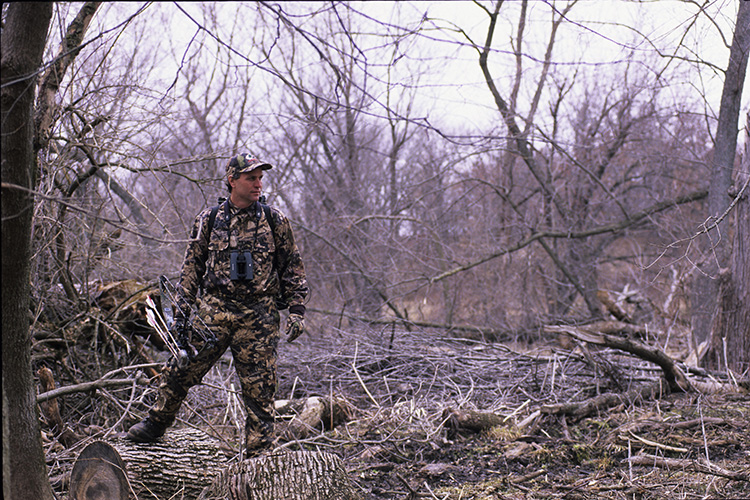
When I started doing TSI back in the mid-90s, there was not much information available. Mostly we learned from seeing the aftermath of commercial timber cuttings and from foresters who, mostly, had a mind only for improving timber value and not for improvement of wildlife habitat.
MY EARLY LEARNING CURVE
I never relied on a specific source of information when I first set out to do Timber Stand Improvement. There wasn’t much at the time (if any). My first project was in 1998. That was on a farm I co-owned. Not much had been published on the subject back then so we looked for help.
The district forester marked the trees to cut with the goal of improving the timber value of key crop trees. Pure forestry goals usually result in less junk trees being removed because the forester only releases specific crop trees and then only removes the competition directly surrounding them.
The forester we worked with was not at all focused on overall habitat improvement and walked right past areas where there weren’t any crop trees to release. Those large areas really needed better habitat, but that was not his goal.
That might be old school thinking as today’s foresters (especially the younger ones) are very likely more in tune with hunting-related goals.
But, that first TSI was a starting point. I got to see how the forest responded to those cuttings in a very low risk way. I was impressed with how the habitat around those released trees improved in just one growing season. That really inspired me to take this habitat work seriously.
Then in the early 2000s, I started buying my own land (no partners). I didn’t have to “get permission” from anyone to be aggressive and focus on hunting-related habitat goals rather than strictly timber value. Despite this fact, I did start slowly. The first year I only did about 10 total acres (at the most). I looked at that area the next summer to see how the habitat responded and then increased the number trees we (I hired a small crew) cut and did another 10 to 20 acres the next winter.
After a couple years of this, I had a pretty good idea how the habitat would respond to different levels of cutting and then I hired a larger crew and over the next two to three years they worked over the entire 800 acres of timber on that farm.
I tapped into government cost share dollars to help pay for this. Some of those programs are still out there and when you accept that help you are not taking that money straight from the taxpayers. Don’t feel bad about it. The funds are already committed. They are going to be spent – so they may as well be spent on your farm.
CONTROL THE INVASIVES FIRST
The main thing I learned (unfortunately, the hard way) was the importance of identifying existing problems first. In other words, if there was an invasive species trying to make a go of it under the canopy of junk trees and then we removed those junk trees, those invasive species went wild.
I had that happen on three or four sites with a total of around 15 to 20 acres and it really bugged me that I didn’t see the problem and fix it first. Those areas were basically ruined unless I dedicated many hours to fixing them – and then with uncertain results. I now have a very deep hatred for invasive species.
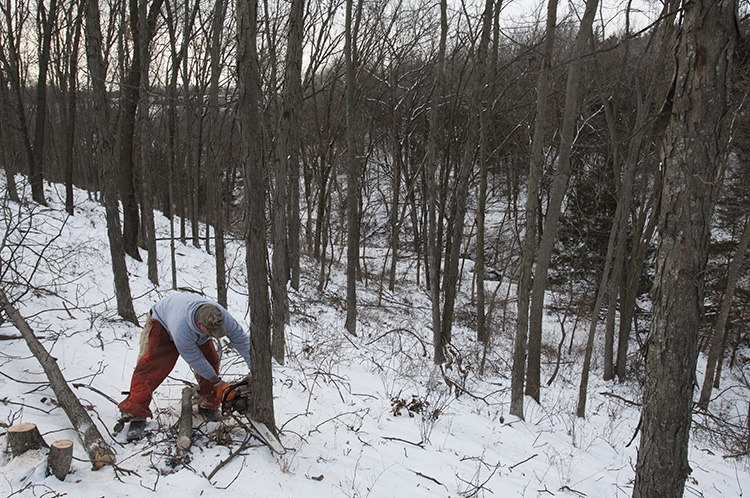
When you open up the canopy, the plants that will thrive are the ones that are already there on the ground level. What you see a little of now, you will see a lot of in a year or two. If those existing plants happen to be invasive species, you are in for a big headache down the road. It is best to eradicate all invasives before cutting down (or killing) any trees.
I should have treated the invasives first and focused my Timber Stand Improvement in other areas until I had the offending plantsw subdued (it can take a few years to clear them). That would have saved a huge problem later when those plants (mostly bush honeysuckle in that area) took off.
Controlling invasives is at least as big of a priority as deciding which junk trees to cut.
You need to be able to identify all the invasives in your part of the country. For example, where I live, I would do an online search under “Invasive plants Iowa” to learn what to look for. Here is an example of what pops up.
They are all bad, but some are worse than others. In my area, Autumn Olive and Bush Honeysuckle can destroy a woodland faster than anything you can imagine if they get opened up. Garlic mustard is another one to eradicate first, if possible.
Despite its name, Tree of Heaven is really bad too. Again, they are all bad, but it is likely you won’t be able to remove them all. Make your list, confer with a local forester and then focus on the worst offenders. That will be a big enough challenge to bite off.
Fortunately, most invasives stay active well past the first frost giving you an opportunity to spot them (they are the only thing in the woods still green). Once you find areas that have invasives, do a number of searches online to determine the best ways to eradicate each of them. In most cases the prescribed treatment will call for a spray of glyphosate after other species are dormant (usually in November in the Midwest) or cut them down and squirt the stump with something like Tordon or Garlon.
I know guys who actually paid to spray glyphosate from crop duster airplanes to cover big areas of their timber after all the “good” species had gone dormant. I guess it worked, but is pretty expensive. No matter what you do, it will take a few years to really get a grip on those areas most affected by invasive species.
Believe it or not, I have actually looked at farms and walked away from the prospect of buying them because the understory was thinly scattered with bush honeysuckle. Any Timber Stand Improvement work to improve habitat on those farms would have resulted in disaster. Regardless of how good those neighborhoods might have been for deer hunting, I didn’t want an open, lifeless, understory nor did I want to deal with an invasive problem long-term. That’s how big of a deal this is.
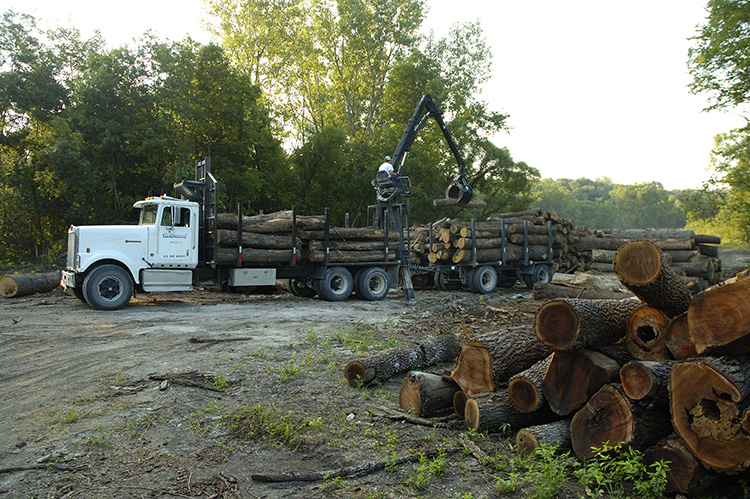
Before starting a TSI program, it is best to do any commercial logging on the property. Depending on the extent of the commercial effort, this logging may greatly open the canopy and this will reduce (or even eliminate) the need for further cutting and encourage lots of ground level undergrowth.
COMMERCIAL TIMBER HARVEST
Ideally, if you think you will do a commercial timber harvest on your property within the next four or five years, I would do it now – before you start the TSI program. The timber harvest will open up some areas that you won’t have to mess with later when doing the TSI.
Also, timber crews hate working around all the downed timber and cut stumps typical of a TSI program.
I don’t want to get distracted by diving into commercial timber goals here, but I have never been a huge fan of cutting down oak trees. A few here and there is fine (and probably healthy for the timber) but those trees produce acorns for deer and turkeys and take a long time to grow.
Instead, I do only a thinning cut on the oaks but really focus more on marketable walnut (where it exists) and species that don’t benefit wildlife.

The aftermath of most logging operations will look like this, lots of pockets with open canopy. This is good for encouraging ground level vegetation. That is what the deer will use for both security and browse. You can’t make any real difference in the ground story of a timber without opening up the canopy.
Even taking out big junk trees (hackberry, some hickory, cottonwood, ash are common examples) for pallet wood (you don’t get much for those trees) is still better than you having to cut them down yourself later.
Again, if there is a commercial harvest anytime in your near future, do that sooner rather than later and then do the TSI afterwards.
GET GOOD ADVICE
I would suggest asking your district forester (for example, Iowa has one for each management district) to come and mark a small TSI program for you. There might even be government cost share in the actual cutting of the trees.
Go along when he/she marks the TSI and ask a bunch of questions. You might mention that you not only want to focus on overall timber quality (the typical goal of TSI in the eyes of most foresters), but also habitat improvement and see if the forester will accommodate. If not, no big deal. Take what you can get.
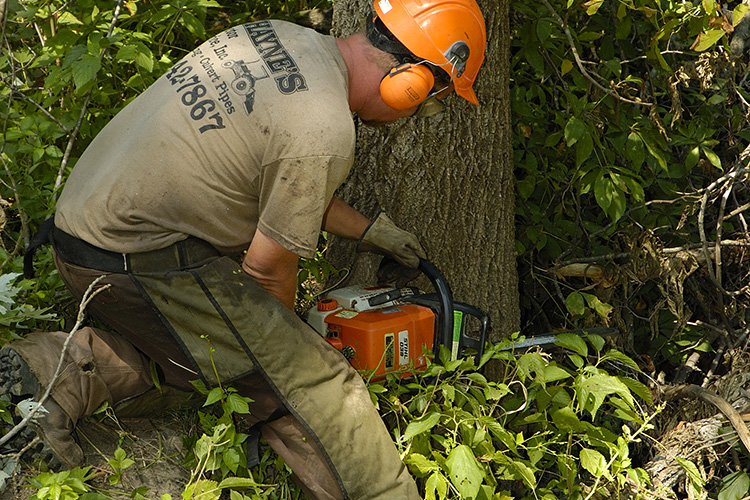
Cutting down trees, even small ones, is very dangerous work. The saw is dangerous enough, but the tree is also a potential widow maker. Wear all the safety gear and unless you know how to fell them safely, stay away from big trees and stick with small trees. Leave the big stuff to the pros.
Unfortunately, those guys are really busy and it may take a long time to get them out there to do this work. Another option is to hire a private consulting forester (do an online search to find them) to come and mark a small area.
Again, go along and ask tons of questions. After he/she leaves you will have a much better feel for how to manage the rest of the property yourself. Start slow. And, do what I didn’t do and look really hard for invasive plants before you dive in and start opening up the canopy.
I would suggest cutting less than you think at first. Granted, you have to get sunlight to the ground to stimulate underbrush and the establishment of some of the key forest species like oak, but you can always come back a year later and recut the same area if you decide you didn’t take enough during round one. Key point: start your learning curve slowly and with patience.
I would be doing you a great disservice if I didn’t also mention the need to be super careful if you decide to cut the trees down on your own. I don’t consider myself a coward, but I am fearful when it comes to cutting down big trees.
There is so much that can go wrong if you don’t know what you are doing – even if you do. Stick with small trees and hire a professional crew for any of the bigger stuff that needs to be removed.
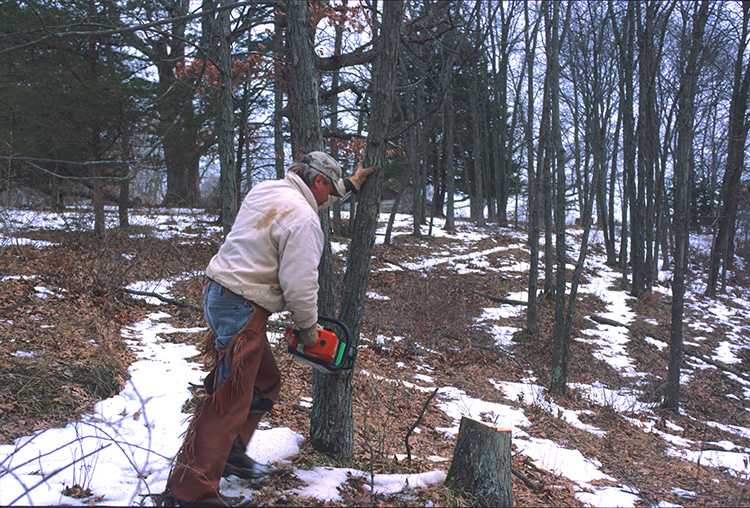
Deciding what to cut is, in many ways, a personal decision, but it is almost always better to be conservative and start slow. You can always cut more the next year if you determine that you didn’t make a big enough change to encourage growth on the forest floor.
WHAT TO CUT AND WHAT TO LEAVE
As for what to cut, that is kind of a personal decision. I left all the obvious marketable timber (even if it was not a desired wildlife species). For example, I left some big hickory trees, some big basswood (linden) and some big maples, knowing these had some value in the near future for timber harvest.
Otherwise, I left almost all the oak, walnut and cherry (walnut and cherry because of their future timber value).
My goal was habitat improvement for whitetail hunting and that meant I needed underbrush – for browse and security – and trees that drop acorns. Those were my two main priorities.
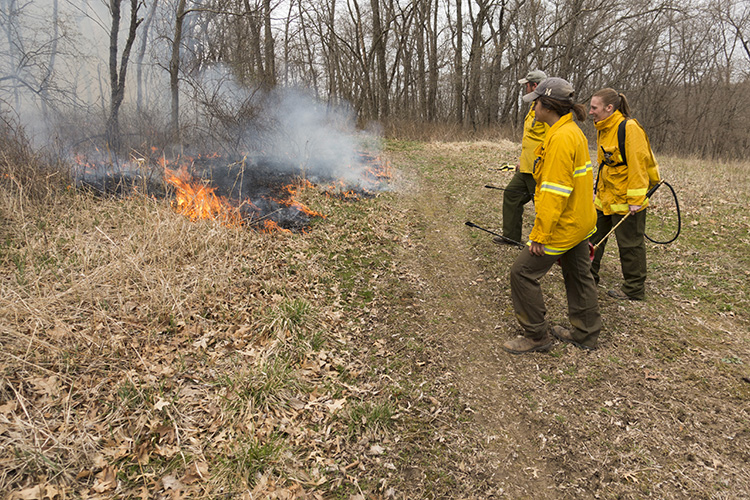
Some land managers prefer to use fire as a way to set back fast growing saplings and restore the forest to a state of early succession with lots of browse. I have used fire on my farm in spots, but I tend to favor using a saw when I come back to past TSI areas several years later.
LONG TERM MAINTENANCE
Timber Stand Improvement is not a one and done process. You will have to go back into those areas roughly every 10 years to cut out all the junk that came up when you most recently opened the canopy.
These new saplings will now be shading the forest floor eliminating those important browse plants. This process should keep the ground level underbrush flourishing (what deer need) and eventually produce a good number of isolated oak trees (assuming there were some seed trees present to begin with).
Some landowners prefer to burn these areas every couple of years to keep them in the early successional stage of regrowth, but I don’t like the non-discriminating quality of fire (it top kills most saplings – not oak – if done correctly).
I always felt better about controlling what died and what didn’t even though it takes a lot longer to do it by hand. Also, top killing only sets back the undesired saplings, it doesn’t kill them.
Maybe I will change my position on fire someday (some land managers swear by it), but right now, I am not going to burn any of my whitetail habitat.
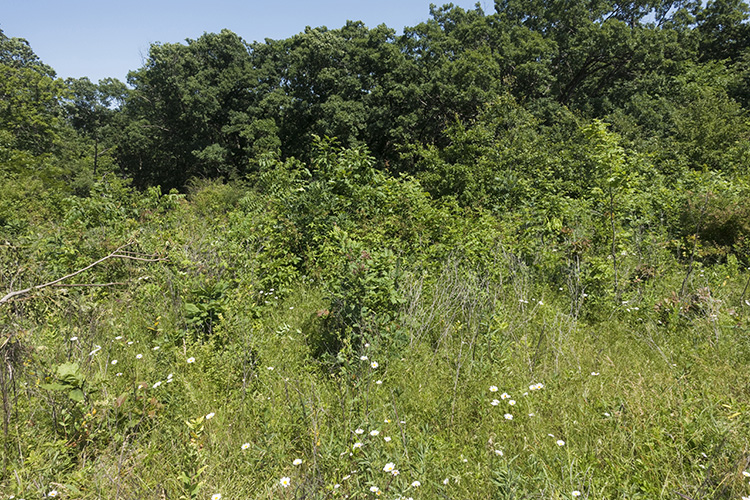
This is the goal, openings that feature lots of browse and good oak regeneration. At least, that has always been my goal when doing habitat work. Oak stands are disappearing across much of the country, and I am always trying to do my part to re-establish them.
MOST IMPORTANT THINGS TO REMEMBER
First, safety is a huge matter when it comes to cutting down trees. If you don’t know what you are doing, stick with small trees when doing the cut yourself.
Further, you are way better off hiring a crew to do this work than taking the risk of having a tree kick back or fall on you. Again, this is super dangerous work! Leave the tricky stuff to the pros.
Second, start slow. I can’t over-emphasize the importance of being patient. Experiment with a small area first. Don’t hurry this early learning process. Do a little, learn from it and then do more. Soon you will be ready to move faster and move correctly. Good luck. (2/3/22)

Another very informative article, Bill. Although I don’t own land (yet), I do have access to a lot of land and also have permission to practice TSI, put in food plots etc. At the end of the day, some would say it’s a waste of time , money and effort doing this work on land I don’t own, but I disagree. I still find the process very rewarding and not only does it keep me busy in the woods all year, but I am also seeing the results in my hunts. Thanks again for putting these articles out!
Thanks Josh. Also, you can learn a lot in experimenting on other people’s farms! Have a great day.
On my small farm Honeysuckle is the bane of my existence. I seem to also see it more every year throughout the great state of Iowa.
Countless hours of cutting and doping w/ seemingly minimal results. It feels at times that I can never stay ahead of its yearly invasive spread.
Regardless, thanks for the informative article as always Bill.
I hate bush honeysuckle. It can ruin a farm if left unchecked. Good luck controlling it. I feel your pain.
Great article Bill! I’ve learned a great amount doing TSI and invasive work on a farm that i don’t own either, great proving grounds. One question with fire though, aren’t oaks fire resistant which would allow you to burn and have them prevail?
Alex, After doing some research, yes, you are correct on that. I didn’t realize it. When I had the forestry group out to my farm to burn, the forester said fire kills saplings. I didn’t ask specifically about oaks. In reality, it doesn’t actually kill the undesirable saplings and bushes either, it only sets them back. That is why you need to burn fairly often to stay ahead of the regeneration from undesirable plants. Personally, I will stick with cutting and spraying the stumps, but I may change my mind about this at some point.
Hi Bill,
I have been a big fan of yours going back to 2014 when I was 15 and stumbled across MW on youtube in school study hall ha. I have been watching ever since up until when you stepped back, at that time I really stepped back as well from watching. Nothing against the guys (Jared,Mike..so on) because I have been watching them since I started following as well. I still watch on occasion but found through watching after your departure that I really liked your information that was given episode after episode with you hosting! I am glad you stepped back and did what you wanted to do! I also am glad that just recently I found this page and have been reading your informative content here, so thank you for continuing that here. I read somewhere that you found a farm and bought one recently? Curious if that was accurate and what your plan is for that? Thanks again and hope you and the family are well!
Charlie, Thanks for the many years of support. I really appreciate that. I will get back into producing another video series – sooner rather than later. I have been discussing it with a few possible sponsors and it looks like it would be well received. I like helping people to become better deer hunters. Maybe that is my calling. I did find a farm to buy and it will be a work in progress. It has been a cattle farm for decades so I don’t have real high hopes for it at first. I will hunt it some this fall, but will also hunt some permission properties and even a bit of public land, just to enjoy the variety. Again, thanks for the note and the support.
Awesome! Excited to see what you can do on that new property! Thanks for quick reply as well!
Really looking forward to the upcoming new videos and information and getting to watch you turn another farm into a whitetail mecca! Completely agree with Charlie i too stumbled across you actually on the midwest whitetail page before youtube and unfortunately the show lost its spark after your step back. Jared and Mike are still full of knowledge and good to watch at any time however the show just seems to be missing something. I cant express enough enthusiasm and gratitude to read that there is more in store for the future from you as i have read all your articles and watched all the videos countless times each! Keep dreaming big Bill!
Bill,
I really enjoy reading your articles and posts and this one really peaked my interest. We just recently had our 80 acres of timber select cut of mostly garbage trees (ash), a few oaks, and a few maples. After the logging was completed we have been left with a mess on the forest floor because of all the left over tree tops. The forester said that the tops would break down in about 5 years. But that seems like a long ways away. Throughout the property there are areas where sunlight can easily reach the ground and new undergrowth has begun. But there are other areas where the tops are too thick on the ground and they are preventing new growth from happening. Right now we are still in the process of clearing the roads/paths that were once there and now are completely covered. So, we don’t have the time to clear those covered dead areas. My question is, what would you to with all the left over tree tops after your TSI or commercial logging was completed?
Cole, Thanks for the note. Regarding the tops, I always left them where they fell. The leaves will come off (if there were any) very quickly and the sun will make its way to at least a percentage of the ground. If that is not happening, then I would probably just throw a chain around a few of the tops and drag them away from the pile with a tractor to open up spaces for the sunlight to shine in. Other than that, you have only one option and that is to wait until the tops break down. I suppose fire is an option, but that just seems like too much fuel to burn through for a nice controlled burn. I would either drag them apart of leave them for nature to manage. Good luck.